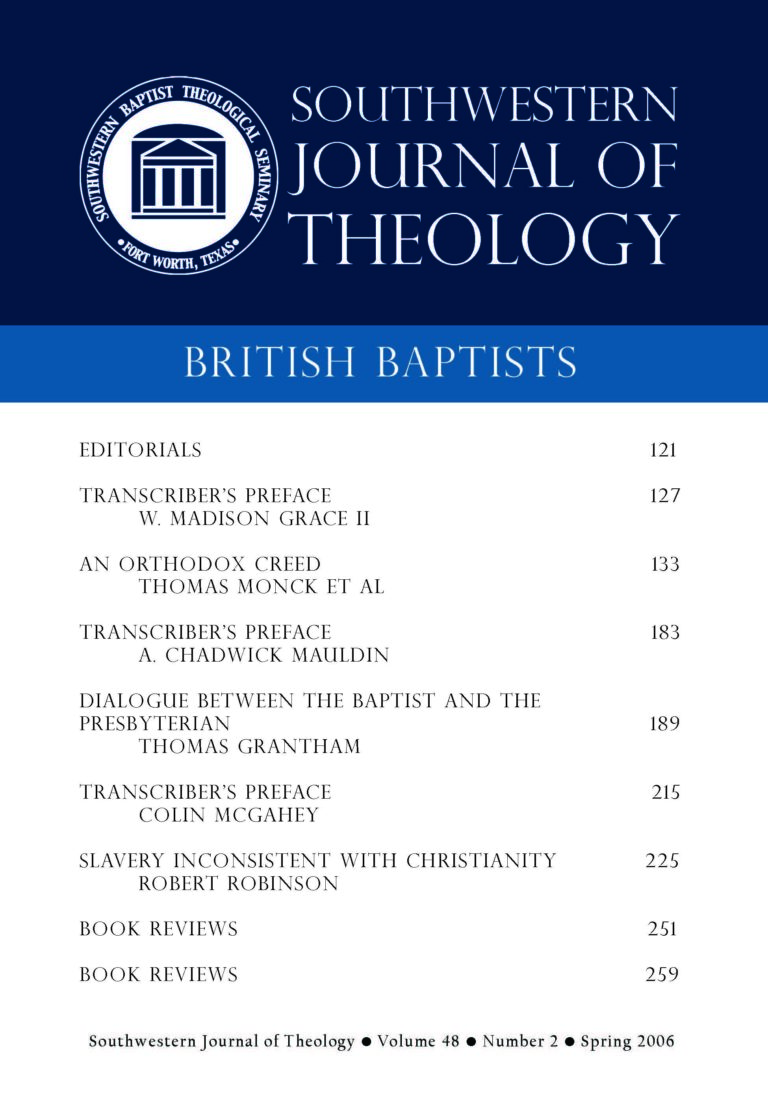
British Baptists
Southwestern Journal of Theology
Volume 48, No. 2 – Spring 2006
Managing Editor: Malcolm B. Yarnell III
Studies in Baptist History and Thought. 2 volumes. By Larry J. Kreitzer. Milton Keynes, UK: Paternoster, 2006. Vol. 1: xviii + 1–533. Vol. 2: xi + 534–1056. Paperback, $89.99.
Who were the early Baptist conventiclers of Oxford? According to Daniel Featley’s The Dippers Dipt, or, the Anabaptists duck’d and plung’d over head and eares they belonged to the lower strata of society, “Russet Rabbies, and Mechanic Enthusiasts, and Profound Watermen, and Sublime Coachmen, and Illuminated Tradesmen” (1:11). Larry J. Kreitzer, Fellow and Tutor of New Testament at Regent’s Park College, Oxford, has done much in ‘Seditious Sectaryes’ to dispel Featley’s caricature of early English Baptists.
The first volume of ‘Seditious Sectaryes’ contains biographical studies of five leaders in the Oxford Baptist conventicles: Richard Tidmarsh, Lawrence King, Roger Hatchman, Ralph Austen, and Thomas Williams. The appendices of the first volume contain the family trees of the Oxford dissenters along with several source documents and a full index. Volume 2 is a chronological source catalog of over five hundred pages containing wills, baptismal records, ecclesiastical proceedings, court judgments, per- sonal letters and more. Kreitzer has graciously translated sources which were in Latin. The selection of individuals for biographical treatment in volume 1 is based on a 1662 court record which identified four of the individuals as Baptist conventiclers, three of whom were charged as ‘seditious Sectaryes & disloyal persons and for being present at an unlawful Conventicle’ (1:18). Kreitzer gives these individuals extended treatment with a chapter devoted to each leader. Kreitzer accomplishes an herculean feat of research by combing through unpublished court, city council, and ecclesiastical documents along with eye witness reports.
Chapter 1 tells the story of Richard Tidmarsh, a successful master tanner and valued civic leader. Municipal leadership proved to be prob- lematic to Tidmarsh and many other Baptists. The chief obstacle was the swearing of oaths, which Tidmarsh refused to do. Tidmarsh was implicated with other dissenters in a supposed plot against Charles II. Such accusa- tions highlighted the anti-Baptist sentiment of the time. Tidmarsh’s name is noted twenty-four times in ecclesiastical court record from 1673–1683. In 1683 Tidmarsh was excommunicated from the Church of England for failing to attend the local parish church. Other documents reveal Tid- marsh as a significant denominational leader, one of which is Innocency Vindicated: or,Reproach Wip’d Off. This 1689 document bears the names of both Tidmarsh and the Particular Baptist luminary William Kiffin.
In chapter 2 Kreitzer examines the glover Lawrence King. King was not only a master craftsman, but also a noted Baptist leader in Oxford, ac- cording to the associational records. King, along with other dissenters, was considered an insurrectionist and troublemaker. Like Tidmarsh and the others, King also made regular appearances before the civil and ecclesiastical authorities to give account for his dissenting activity.
Chapter 3 treats Roger Hatchman, a stone mason turned soldier, who joined the company of “seditious sectaryes and disloyal persons” when he stood before the Oxford Petty Sessions court on January 9, 1662. Hatchman, Tidmarsh, and King were jailed in the Bocardo prison located at the North Gate of Oxford. Their crime was a refusal to swear an oath of allegiance to Charles II. Imprisonment did not have the desired effect, for one year later Hatchman stood before court again sccused of dissent.
In chapter 4, Kreitzer judges Ralph Austen to be the most notable of the Oxford Baptist conventiclers charged in the 1662 court document. Austen served as Register for the Visitors of Parliament for a number of years. Such a distinguished position and responsibility gives evidence of Austen’s recognized ability and loyalty. Austen was also a noted gardener, horticulturalist, and cider-maker whose reputation and publications on fruit trees caught the attention of the Royal Society and Isaac Newton.
The final biographical chapter focuses on Thomas Williams the milliner. Williams was not only a successful tradesman, but also progressed in civic affairs. From 1633 to 1643 he rose through the ranks of civic office from the position of constable to member of the city council. The highlight of Williams’s municipal career was his service as mayor in 1653. Kreitzer observes that ecclesiastical records reveal Williams’s activity of religious dissent significantly increased after his 1664 marriage to a dissenting wife. Prior to their wedding Williams was apparently comfortable working for reform within the establishment.
‘Seditious Sectaryes’ stands as a definitive work on early Oxford Baptists. The volumes bristle with footnotes and references to ecclesiastical and court documents that sometime leave the reader longing for a diary entry, sermon or portrait of the subjects. The unavailability of such sources only serves to magnify Kreitzer’s accomplishment. In the end Kreitzer effectively reveals the Baptist conventiclers of Oxford to be in large part a conscientious, responsible people of peculiar genius, neither seditious nor sectarian in a negative sense. ‘Seditious Sectaryes’ breathes life into the obscure beginnings of Oxford Baptists, who frequently found themselves between the Rock and a hard place.





